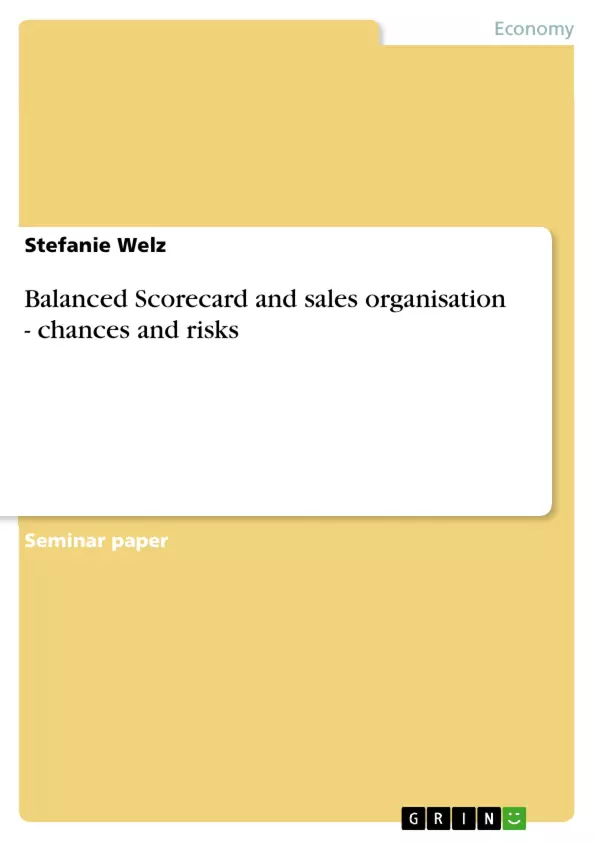The assignment “Balanced Scorecard and sales organization - chances and risks” starts with the introduction which includes the executive summary and the scope of work that is realized in here. The second chapter deals with a detailed definition of the problem that causes the relevance of this assignment, the determination of the objectives as well as the methodology that describes the assignment’s structured procedure. Chapter three is focused on the basics of the balanced scorecard. At this juncture in particular the characteristics and definition of the balanced scorecard, the balanced perspectives as well as the cause and effect relationship are being analyzed. Chapter four is about the application of the four already described perspectives to sales organization and the corresponding chances and risks for the sales organization by implementing the balanced scorecard. Finally, the results of this assignment are summarized; especially whether the set objectives are reached as well as critical comments about the assignment is given in the last chapter.
Inhaltsverzeichnis (Table of Contents)
- Introduction
- Executive Summary
- Scope of Work
- Problem and Research
- Problem Definition
- Relevance and Motivation
- Methodology
- Basics on Balanced Scorecard
- Characteristics and definition
- Vision and Strategy
- Four Balanced Perspectives
- Financial Perspective
- Customer Perspective
- Internal Business Perspective
- Learning and Growth Perspective
- Cause and effect chain
- Application of the four perspectives to sales organization
- Perspectives
- Financial Perspective
- Customer Perspective
- Internal Business Perspective
- Learning and Growth Perspective
- Advantages and disadvantages
- Perspectives
Zielsetzung und Themenschwerpunkte (Objectives and Key Themes)
This assignment aims to explore the implementation of the Balanced Scorecard (BSC) in sales organizations and its impact on strategic success. The assignment delves into the characteristics and application of the BSC within a sales context, analyzing the advantages and challenges it presents.
- The importance of the Balanced Scorecard (BSC) in supporting strategy implementation.
- The application of the four BSC perspectives (financial, customer, internal business, and learning & growth) to sales organizations.
- The advantages and disadvantages of implementing the BSC within sales organizations.
- The potential for the BSC to contribute to the successful implementation of a company's strategy.
- The relationship between sales performance and the BSC framework.
Zusammenfassung der Kapitel (Chapter Summaries)
The introductory chapter establishes the context of the assignment and introduces the Balanced Scorecard (BSC) as a performance measurement tool. It outlines the scope of the research and explores the significance of the BSC in the context of strategic implementation. Chapter two delves into the problem definition, highlighting the challenges of successfully implementing a company's strategy and the role of the BSC in overcoming these challenges. The chapter also discusses the relevance and motivation behind studying the BSC in relation to sales organizations, emphasizing the importance of aligning sales performance with strategic goals. The methodology section outlines the research approach employed, which involves examining both existing literature (secondary research) and real-world examples (primary research).
Chapter three provides a detailed explanation of the BSC's fundamental principles, including its characteristics, definition, and the four core perspectives: financial, customer, internal business, and learning & growth. This chapter also explores the concept of cause and effect chains within the BSC framework, demonstrating how different perspectives interact and contribute to overall performance.
Chapter four explores the practical application of the BSC's four perspectives to sales organizations. This chapter examines the benefits and challenges of implementing the BSC in a sales context, considering the specific measures and objectives relevant to sales performance. The chapter also assesses the potential advantages and disadvantages of using the BSC in sales organizations, highlighting potential risks and opportunities associated with its implementation.
Schlüsselwörter (Keywords)
The primary focus of this assignment is on the Balanced Scorecard (BSC) and its application in sales organizations. Key themes include strategic implementation, performance measurement, sales organization, and the four BSC perspectives: financial, customer, internal business, and learning & growth. This research explores the potential of the BSC to improve strategic alignment and enhance sales performance while also considering the risks and challenges associated with its implementation.
- Arbeit zitieren
- Stefanie Welz (Autor:in), 2006, Balanced Scorecard and sales organisation - chances and risks, München, GRIN Verlag, https://www.grin.com/document/73460



